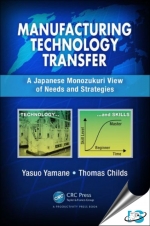Based on a bestselling book originally published in Japanese, Manufacturing Technology Transfer: A Japanese Monozukuri View of Needs and Strategies offers time-tested methods and little-known tips for achieving successful transfer of technology along with the skills required to operate that technology. Designed to support a series of lectures on technology transfer within a master’s course on the management of technology, it presents the results of years of research carried out at Hiroshima University.
The book delves into the authors’ decades of experience transferring technology between Japan and the rest of the world, particularly to developing countries from where much of the world’s future economic growth is expected. It contains case studies of successful technology transfers from both the ship building and food equipment industries. Its wide-reaching coverage examines methods of skill transfer, production management, and manufacturing company classification.
Introducing readers to the engineering activities that occur within the manufacturing industry, the book illustrates the engineering technology activities involved in manufacturing, along with the production management activities required to support them. It also explains how job simulators can help shorten learning times in the manufacturing industry in the same way that flight simulators are used to teach flying skills to pilots.
The book outlines a framework for teaching and learning processes that can be visualized in terms of an S-shaped learning curve. It explains how technology transfer overseas should be supported by contractual agreements between the parties concerned. Detailing the legal/contractual responsibilities for all parties involved, it also describes what you should do if problems arise during the transfer.
Integrating previously unpublished research results with illustrative case studies, this book is suitable for a wide audience within the manufacturing industry—including manufacturing engineering students in both developed and developing countries, those responsible for the development of manufacturing engineers in industry and elsewhere, and anyone interested in the international activities of Japanese manufacturing companies.
Preface
Chapter 1 : Manufacturing Industry
-
The Machine Tool Manufacturing Process
-
Information and Object Flows in Manufacturing
-
Compatible Manufacturing Methods
-
Changes in Processing Accuracy
-
Classification of Manufacturing Industry and Products by Number of Parts and Processing Accuracy
-
Industrial Field and the Type of Technical Skill Required
-
Abilities Required by Engineers and Technicians
-
Discussion Questions
Chapter 2 : Learning Curves and Their Utilization
-
The Learning Curve
-
Engineering Equivalents to the Learning Curve
-
Specification of Skill Levels by Means of Learning Curves
-
Industry Field Surveys
-
Skill Level and Standard Deviation
-
Discussion Questions
Chapter 3 : Skill Transfer in Manufacturing Industries
-
Technology and Skill Transfer
-
Work De-Skilling
-
The Security of Technology Transfer
-
Turnover Rate and Technology/Skill Transfer
-
Discussion Questions
Chapter 4 : Virtual Manufacturing to Speed Up Learning
-
Hand Scraping
-
An Experimental Study of Expert Scraping Judgments
-
Hand Scraping Strategy
-
Computer Simulation of Scraping
-
Computer Simulation and Education
-
Discussion Questions
Chapter 5 : Production Management and Technology Transfer in Manufacturing
-
Production Management
-
The Product Life Cycle
-
Technology Transfer and Management of Technology
-
Discussion Questions
Chapter 6 : Overseas Expansion and Technology Transfer
-
Special Features of Technology Transfer Overseas
-
Historical Background to Overseas Technology Transfer
-
Overseas Expansion and Conditions of Technology Transfer
-
Future Trends in Overseas Technology Transfer
-
Discussion Questions
Chapter 7 : Technology Transfer and Legal Affairs
-
Function of Legal Affairs in Technology Transfer
-
Example Framework of Agreement Covering Technology Transfer
-
Common Points to Note in the Various Agreements’ Legal Affairs Articles
-
Discussion Questions
Chapter 8 : Technology Transfer from Participants’ Viewpoints
-
Background of Technology Transfer
-
New Technology Transfer—Issues That Should Be Tackled
-
A Technology Transfer Survey
-
Results from the Survey
-
Road Map for Resolving Problems
-
Discussion Questions
Chapter 9 : Overseas Expansion Technology Decision Making
-
Overseas Expansion and the Learning Curve
-
Problems after Transfer
-
Overseas Expansion Decision Making Using Block Diagrams
-
Discussion Questions
Chapter 10 : Example of Shipbuilding Industry in Overseas Technology Transfer
-
General Survey of Shipbuilding Transfers and Selection of Successful and Unsuccessful Cases
-
Case Study 1: Tsuneishi Heavy Industries
-
Case Study 2: Technical Cooperation in Shipbuilding to Indonesia
-
Conclusion
-
Discussion Questions
Chapter 11 : Example of Overseas Expansion (Food Machinery)
-
The Subsidiary Companies’ Products
-
Manufacturing Effectiveness and Costs
-
Other Factors to Consider
-
Overseas Expansion Example: Thailand
-
Summary
-
Discussion Questions
Index

























